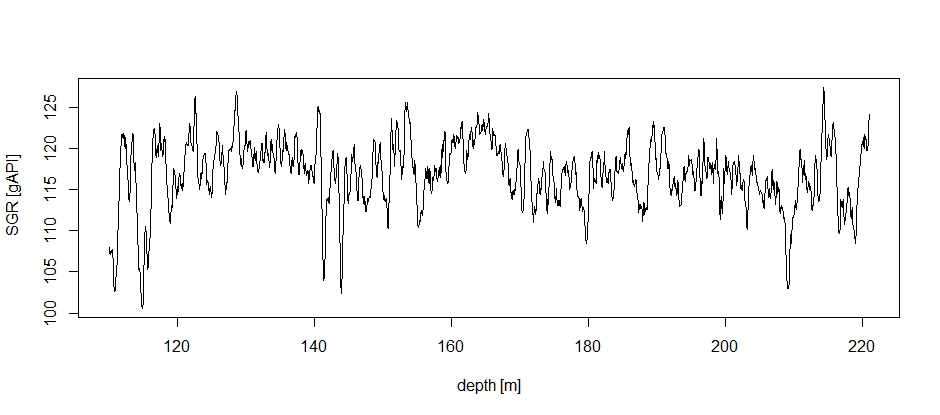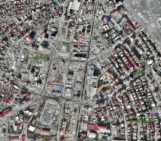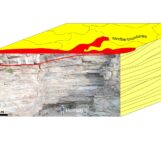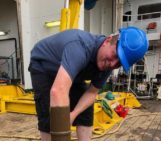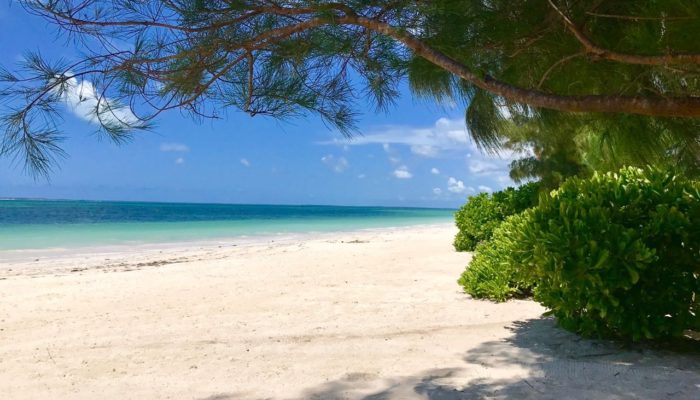
Most people would not relate Central Europe to a tropical environment today. During the Middle Jurassic (174-163 Ma ago), however, such conditions prevailed in most parts of the nowadays landmass that was almost completely covered by a shallow epicontinental sea (estimated 0-100 m water depth) except for several emerged areas and islands. During this time, the continent of Pangaea broke apart, as the early spreading of the Atlantic Ocean initiated, leading to sea level high stands of about 50-70 m above today’s level. Geographically, Europe was located at latitudes about 15° further south compared to present, partly placing it into tropical climate conditions. Connections to open oceans existed to the Boreal Sea in the north via the Viking Strait and to the subtropical southern Tethys Ocean via some broad seaways (Fig. 1). Several sub-basins formed in this shallow sea e.g. the North German Basin, Paris Basin, Polish Basin, as well as the South German Basin. All these basins were affected by numerous marine ingressions from north and south, leading to very diverse and different lithostratigraphic records. Here we focus on the South German Basin that was characterised by predominantly fine-grained clastic sediment input deposited within a tropical climate, including dark clays and oolithic ironstones. The source of the sediments were adjacent islands, which have gradually been eroded and completely submerged.
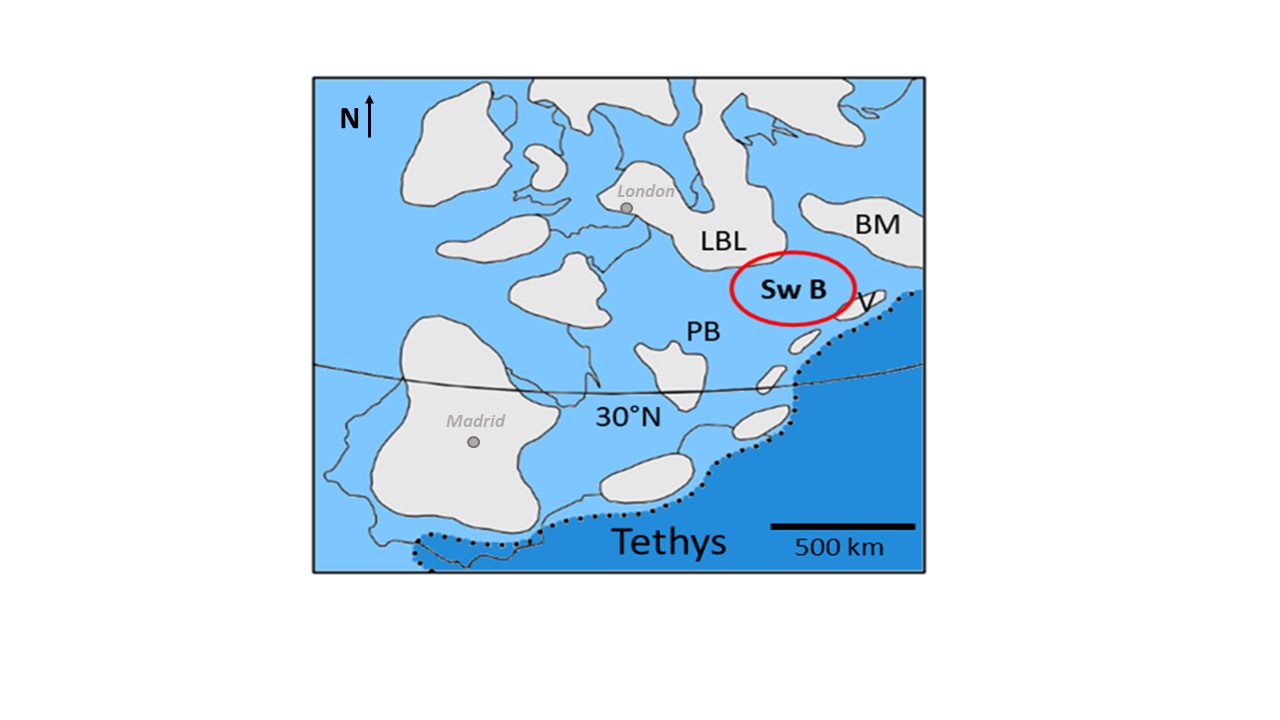
Figure. 1 : Map of Central Europe during the Middle Jurassic (modified after Leu et al., 2023). Emergent areas are marked in grey, shallow epicontinental sea in light blue. Cities of London and Madrid are included for position-reference. LBL – London-Brabant-Landmass, BM – Bohemian Massif, PB – Paris Basin, V – Vindelicia, Sw B – Swabian Basin. The red circle marks the investigated region of former Southern Germany. The dashed line and dark blue represents the expected realm of the Tethys Ocean.
Despite the available information about palaeo-environmental conditions in Central Europe during the Jurassic, the sedimentation rates during the Aalenian stage (~174-170 Ma) elude us still, especially for the South German Basin. To complement our understanding of environmental conditions during this time, we performed cyclostratigraphy on strata of the Middle Jurassic in southern Germany. The Swabian Alb is part of the South German Basin and one of the most distinctive regions in Germany, where Jurassic strata are exposed. From this area, three drill cores exhibiting lengths of 200-250 m and comprising sediments from the Early to the Middle Jurassic (~201-166 Ma; Fig. 2) were investigated. 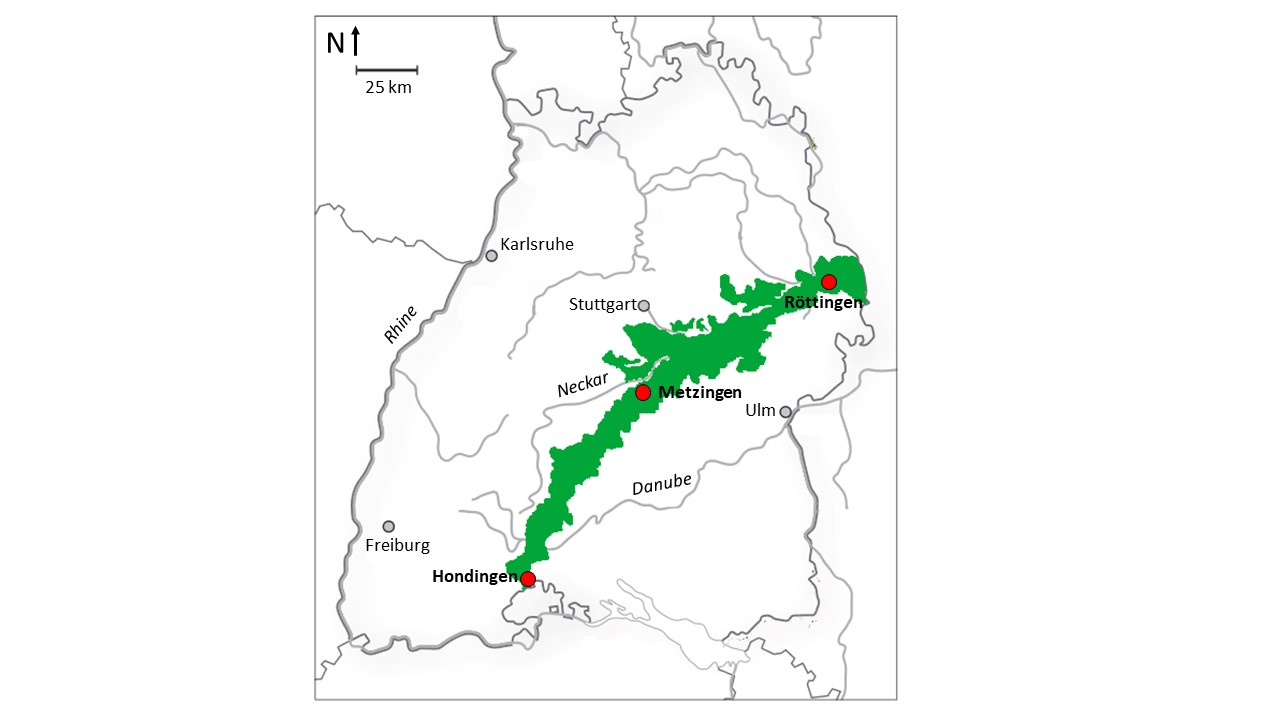
Figure 2: Map of southwest Germany today (modified after Leu et al., 2023). Green area marks outcropping Early–Middle Jurassic strata of the Swabian Alb. Red dots represent the investigated drill sites Röttingen, Metzingen and Hondingen.In order to perform robust cyclostratigrapic analyses, some data properties are desirable: the stratigraphic interval needs to show an adequate thickness without major changes in lithology and it should be as stratigraphically complete as possible. Here, the interval considered best for cyclostratigraphic analyses comprises the Lower Aalenian, containing thick and largely homogenous claystones.
For the analysis, downhole logging data of the three drill sites (Fig. 3) has been used, as it has several advantages in comparison to core data (beside other disadvantages), e.g. a continuous data record, a high accuracy depth measurement and measured in-situ conditions. In particular, the spectral gamma ray (SGR) is often useful to perform cyclostratigraphy. This proxy is mainly influenced by the natural radioactivity of rocks due to the decay of 40K, 238U, 234U, 235U and 232Th, and their daughter isotopes. Potassium can mostly be found in K-feldspars, micas and illitic clays, whereas thorium typically occurs in sand- and silt-sized heavy minerals or in the fine-grained fraction in association with clay minerals. Uranium may be present in heavy minerals and under anoxic lake environments where it precipitates out of the water and forms complexes with other elements. As organic matter acts as a reductant in lake environments, U may be concentrated in organic matter too. In most cases high spectral gamma-ray values indicate the presence of fine-grained or clay-rich sediments such as shale, claystone and mudstone, whereas low spectral gamma-ray values represent coarse-grained or carbonate lithologies. In our study, the SGR log clearly reflects orbital cycles.
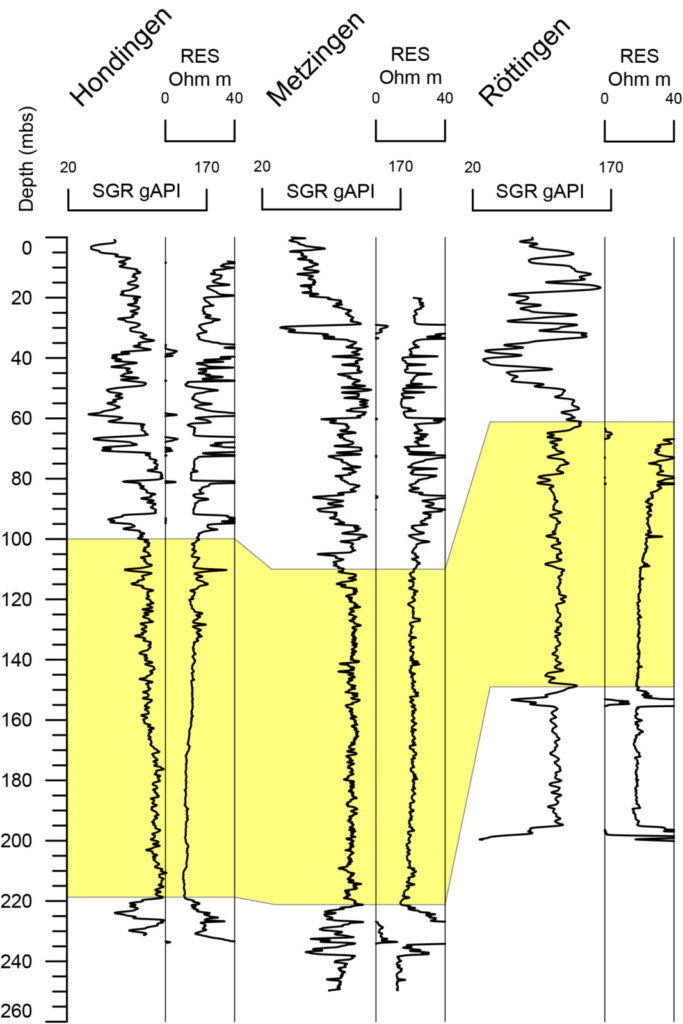
Figure 3: Correlation of spectral gamma ray (SGR) of Hondingen, Metzingen and Röttingen boreholes. The investigated part is marked in yellow (modified after Leu et al., 2023).
Cyclostratigraphy is a geochronological method that relates quasi-periodic changes of the earth’s orbit around the sun, the so-called Milanković cycles to quasi-cyclic alterations in geoscientific datasets. These orbital cycles influence the solar insolation on Earth and therefore, may impact its climate. The climate in turn affects the chemical and physical properties of deposited sediments e.g., through erosion and weathering which is reflected by changes in grain size, mineralogy and abundance or organic carbon content, and is in our case measurable by the physical and chemical characteristics of the sediments.
The main periodicities for orbital variations include eccentricity cycles of 405 kyr and ~100 kyr, obliquity cycles of ~41 kyr and precession cycles of 23 kyr and 19 kyr. Looking deeper into the past, obliquity and precession periodicities experience slight changes in durations. However, the 405 kyr-eccentricity cycle is considered to be very robust in duration through Earth history. Establishing a relationship between orbital forcing and the sedimentary record enables the reconstruction of an astrochronology with high temporal resolution that provides a valuable framework for the timing of Earth system processes.
After a first visual pattern recognition of cyclicity in the SGR curve, its presence has to be confirmed statistically. For this, several methods can be applied that aim to detect and extract cyclicity in datasets and to assess their frequency (Fig.4; for details the interested reader is referred to Leu et al., 2023),
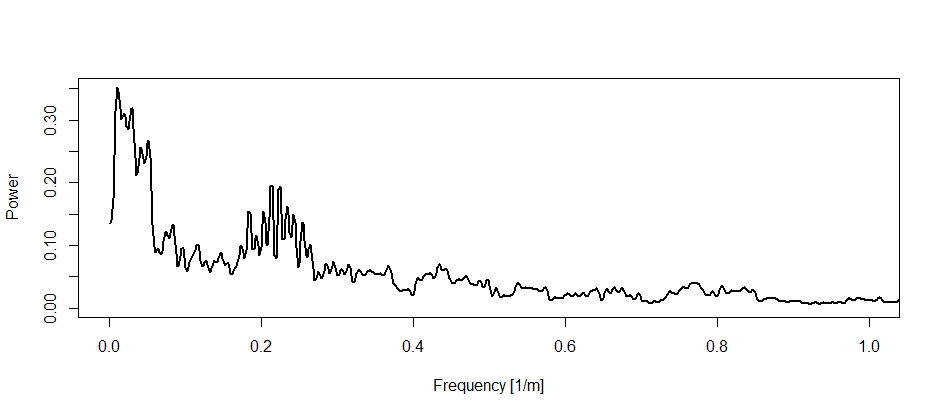
Figure. 4 Top: SGR curve of the investigated part of the Opalinuston Formation from the Metzingen borehole (110-221 m). Below: Power spectra received using the multi taper method (MTM) on the same succession, indicating that sedimentary cycles of specific frequencies are present.
Cyclostratigraphy provides similar timespans for the Lower Aalenian of two boreholes (925 kyr) and (1018 kyr), with slightly varying sedimentation rates of 9.5 cm/kyr to 10.9 cm/kyr. The third borehole comprises a slightly shorter timespan of about 855 kyr with a higher sedimentation rate of 13.8 cm/kyr. This is caused by the diachronous base of the investigated Opalinuston Formation in southern Germany. Lithologies of similar facies within the Opalinuston Formation have formed under similar conditions but during different times. Furthermore, it is likely that the variations are also caused by local or bathymetrical circumstances, considering the extend of ~150 km of the transect on which the drill sites are located. The received sedimentation rates (9.5–13.8 cm/kyr) are higher than what is usually expected for argillaceous deposits, but are considered as reasonable because the Opalinuston Formation is known for relatively high sedimentation rates. Taking the challenge that is associated with precisely inferring timespans in deep time (>50 Ma) into account, the results are notably accurate and conform to other estimations of the Lower Aalenian time e.g. the Colle di Sogno section in northern Italy, in which the whole Opalinuston Formation is estimated to comprise ~2 Ma.
Our astrochronological study provides a new benchmark for parts of the Middle Jurassic in southern Germany that have not been investigated so far. Through this, a base is set to establish a link between depositional environments of the Aalenian in northern Switzerland and the Aalenian in northern Germany.
References
Callomon, J. H. (2003). The Middle Jurassic of western and northern Europe: Its subdivisions, geochronology and correlations. GEUS Bulletin, 1, 61–73. https://doi.org/10.34194/geusb.v1.4648
Franz, M., & Nitsch, E. (2009). Zur lithostratigraphischen Gliederung des Aalenium in Baden-Württemberg. LGRB-Informationen. (22), 123–146.
Hinnov, L. A., & Park, J. J. (1999). Strategies for assessing Early—Middle (Pliensbachian—Aalenian) Jurassic cyclochronologies. Philosophical Transactions of the Royal Society of London. Series a: Mathematical, Physical and Engineering Sciences, 357(1757), 1831–1859. https://doi.org/10.1098/rsta.1999.0403
Leu, K., Zeeden, C., Mann, T., Erbacher, J., Bornemann, A., Wonik, T. (2023). Cyclostratigraphy of the Lower Aalenian Opalinuston Formation in the Swabian Alb deduced from downhole logging data. ZDGG (Zeitschrift der Deutschen Gesellschaft für Geowissenschaften). https://doi.org/10.1127/zdgg/2023/0373
Nitsch, E., & Franz, M. (2009). Der Frühe und Mittlere Jura. Lebensraum Jurameer. Biologie in unserer Zeit, 39, 278-287. https://doi.org/10.1002/biuz.200910400
.

